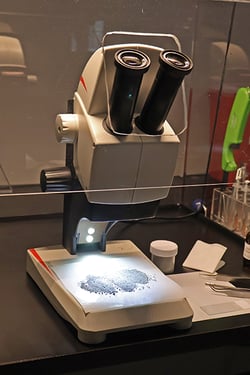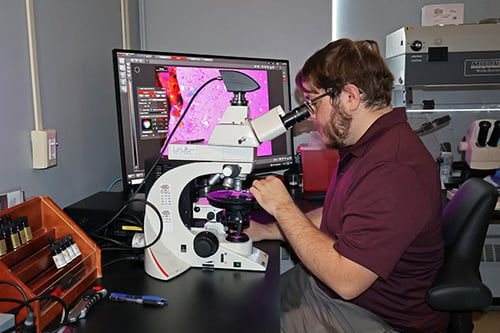At RJ Lee Group, optical microscopy is a cornerstone of our materials characterization services. Our extensive microscopy department is equipped with a wide range of advanced instruments and staffed by experienced analysts who specialize in visualizing and interpreting material structures at the micro level. Whether supporting environmental investigations, forensic casework, or industrial quality control, our team applies expert techniques to uncover critical insights from even the most complex samples. This page highlights three key optical methods—Polarized Light Microscopy (PLM), Phase Contrast Microscopy (PCM), and Stereo Microscopy (SM)—and how they contribute to our comprehensive analytical capabilities.
Instrumentation
Optical Microscopy
Polarized Light Microscopy (PLM)
Polarized Light Microscopy (PLM) is a powerful technique that uses polarized light to examine materials with anisotropic properties—those that interact with light differently depending on direction. By analyzing optical behaviors such as birefringence and extinction angles, PLM reveals detailed structural and compositional information that is often invisible under standard brightfield illumination.
This method is especially effective for identifying crystalline substances, synthetic fibers, and mineral particles. In materials analysis, PLM is widely used for contamination studies, forensic investigations, and quality assurance in industries where precise material identification is critical.

Phase-Contrast Microscopy (PCM)
Phase Contrast Microscopy (PCM) is an optical technique that enhances the visibility of transparent or low-contrast specimens without staining. It works by converting subtle phase differences in light waves—caused by variations in thickness or refractive index within a sample—into intensity differences that appear as contrast in the image.
This makes PCM especially useful for examining fine structural details in materials such as polymers and fibers. In materials analysis, PCM is commonly used to detect contaminants, assess surface features, and evaluate the uniformity of transparent films or coatings, providing valuable insights into quality control and failure investigations.

Stereo Microscopy (SM)
Stereo Microscopy, also known as stereoscopic or dissecting microscopy, provides a three-dimensional view of a specimen at relatively low magnification. It uses two separate optical paths to create depth perception, making it ideal for examining the surface features, texture, and morphology of larger or irregularly shaped materials.
In materials analysis, stereo microscopy is commonly used for inspecting fractures, identifying foreign particles, and documenting sample conditions before further testing. Its ease of use and ability to provide real-time visual assessment make it a valuable tool in both routine inspections and detailed failure analysis.


How we use optical microscopy
Clients rely on optical microscopy for a range of analysis:
- Identify unknown materials in complex matrices.
- Characterize foreign particulate matter (FPM) in pharmaceutical and medical device investigations.
- Analyze asbestos content in bulk materials for regulatory compliance.
- Support forensic and industrial investigations with high-resolution optical data.
- Determine optical properties using methods like the Becke Line technique.
Whether you're evaluating contamination in a cleanroom or verifying the composition of a legacy material, PLM provides the clarity and precision needed to make informed decisions.
Why Choose RJ Lee Group for Optical Microscopy?
RJ Lee Group brings decades of experience and a deep bench of technical expertise to every optical microscopy project. Our laboratory houses a robust suite of instruments—including polarized light, phase contrast, and stereo microscopes—supported by analysts who are highly trained in both classical and advanced microscopy techniques.
We tailor our approach to meet the specific needs of each client, whether it's identifying unknown materials, evaluating contamination, or supporting regulatory compliance. With a commitment to precision, reliability, and scientific integrity, RJ Lee Group is a trusted partner for organizations seeking actionable insights through optical analysis.
What Sets Us Apart:
- Accredited Laboratory: RJ Lee Group is ISO/IEC 17025 accredited, ensuring our methods meet rigorous standards for quality and reliability.
- Certified Analysts: Our team includes analysts certified in asbestos analysis (NIOSH 7400, PLM), forensic microscopy, and other specialized disciplines.
- Integrated Analytical Services: Optical microscopy is often paired with SEM/EDS, FTIR, XRD, and other techniques for comprehensive materials characterization.
- Industry Expertise: We serve clients across pharmaceuticals, environmental science, manufacturing, aerospace, forensics, and regulatory sectors.



Get in Touch
Ready to learn more about how PLM can support your project? Whether you're facing a regulatory challenge, a product quality issue, or a materials mystery, RJ Lee Group is here to help. Contact our team to discuss your needs and explore how PLM can deliver the answers you're looking for.
Blog
Read More
10 min read
Unlocking the Secrets of Materials: The Power of X-ray Diffraction (XRD) and X-ray Fluorescence (XRF)
October 01, 2024



